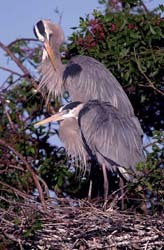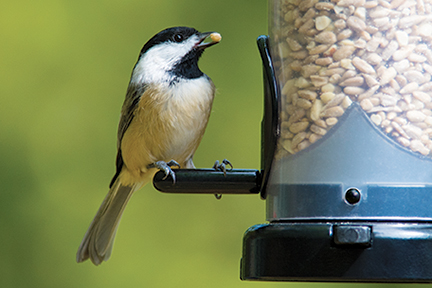BIRD OF THE MONTH
Great Blue Heron
The Great Blue Heron is a majestic sight whether it is standing motionless at a river bend or cruising along the coastline with slow, deliberate wingbeats. This stately bird with its beautiful blue-gray plumage will poise without moving, scanning for prey or wade belly deep with long, deliberate strides. Great Blue Herons may move slowly but they can strike like lightning to snag a fish or grab a frog.
Great Blue Herons live in both freshwater and saltwater habitats. They usually hunt alone eating fish, reptiles, insects and other birds. They will also forage in grasslands and agricultural fields looking for frogs and small mammals.
When building a nest, the male Great Blue Herons collect much of the material, gathering sticks from the ground, shrubs, trees and unguarded or abandoned nests. They present the sticks to the females. If the sticks are accepted, the females proceed to weave a platform and a saucer-shaped nest cup. The nest is lined with pine needles, moss, reeds, dry grass and small twigs. Building the nest can take from 3 days up to 2 weeks. Each female will lay 3 - 6 pale, blue eggs.
Great Blue Herons nest mainly in trees but will also nest on the ground, on bushes and on structures such as duck blinds, channel markers or nesting platforms. Males arrive at the colony first and select a nest site. They then begin to court the females. Large, successful colonies may have hundreds of nests.
Great Blue Herons are monogamous during a breeding season but choose new partners each year. They display elaborate courtship and pair-bonding behaviors including a ritualized greeting, stick transfers and a nest relief ceremony in which the birds erect their plumes and clap their bill tips together.
Great Blue Herons defend their feeding territories with much drama, approaching intruders with head thrown back, wings outstretched and bill pointing skyward. Offending humans may also witness this behavior.
OTHER COOL FACTS ABOUT GREAT BLUE HERONS
Great Blue Herons are the largest heron in North America.
Great Blue Herons can curl their neck into an S shape for more aerodynamic flight and to quickly strike prey at a distance due to specially shaped neck vertebrae.
Great Blue Herons have specialized feathers on their chest that continually grow and fray. The herons comb this "powder down" with a fringed claw on their middle toes, using the down like a washcloth to remove fish slime and other oils from their feathers as they preen. The powder protects their feathers against the slime and oils of swamps.
Great Blue Herons can hunt day and night due to a high percentage of rod-type photoreceptors in their eyes.
Even though Great Blue Herons are impressive standing about 4 feet tall and having a 6 foot wing span, they only weigh 5 to 6 pounds because of their hollow bones.
Great Blue Herons on the coast an be seen poised atop a floating bed of kelp waiting for lunch to swim by.
On March 17, 2003 the Seattle City Council named the Great Blue Heron the official bird of Seattle.
Based on banding records, the oldest Great Blue Heron was 24 years old.
Fish farmers worry about Great Blue Herons congregating at fish hatcheries, but a study found that the birds ate mostly diseased fish that would have died shortly anyway. The sick fish spent more time near the surface of the water where they were more easily snagged by the herons.
This spring a local heronry will be stirring to life. Numerous nests were accounted for last year at the colony behind the King County Animal Shelter at 21615 64th Ave. S. in Kent. Visit, observe and be awestruck by these magnificent and interesting birds

